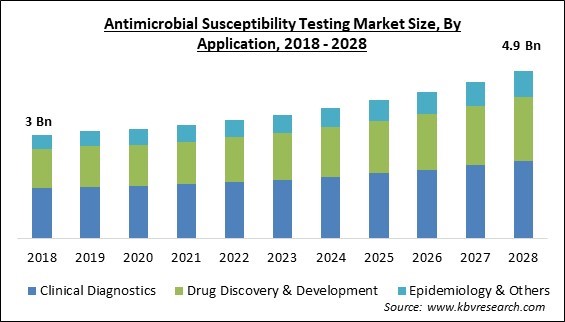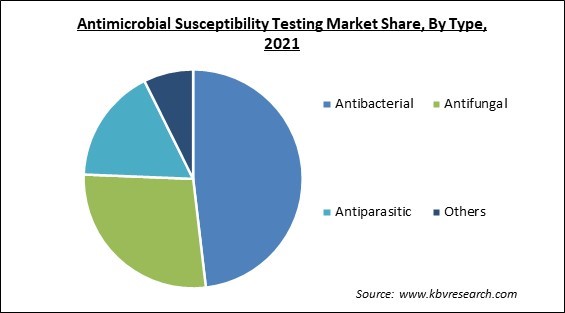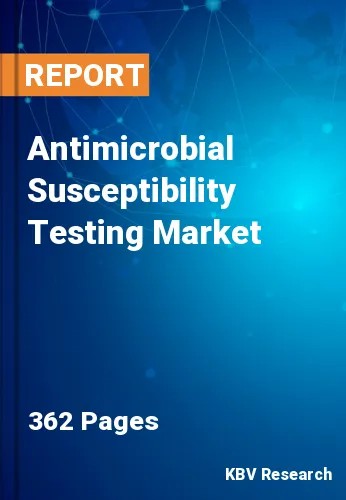The Global Antimicrobial Susceptibility Testing Market size is expected to reach $4.9 billion by 2028, rising at a market growth of 5.9% CAGR during the forecast period.
Antimicrobial susceptibility testing (AST) is a technique used to determine which antimicrobials a particular organism or organism group is resistant to. Susceptibility arises when microorganisms like fungi and bacteria cannot survive with one or more antimicrobial drugs. It is a laboratory technique to determine which antimicrobial treatment is most effective against microorganisms. In addition, it is used to determine which antibiotic inhibits the growth of bacteria, fungi, and other pathogens that cause illness.

After microorganisms that cause illness, like fungi, bacteria, and viruses, have been isolated from a culture of the specimen, susceptibility testing is conducted on them. Antimicrobial susceptibility testing (AST) is performed to examine the potential effectiveness of different antibiotics on bacteria and/or whether bacteria have developed resistance to particular antibiotics, along with antifungal or antiviral species. The findings of this test may be employed to select the medication(s) most likely to efficiently treat a disease. They have access to antibiotics.
AST contributes to evaluating treatment services offered by hospitals, clinics, and governmental programs to control and prevent infectious diseases. The testing determines the sensitivity of a bacterial, fungal, or viral strain to a panel of antifungals, antibiotics, and antivirals. In addition, the test examines if the bacterium can grow in the presence of these antimicrobials by exposing it to them. This information is provided to physicians in the form of the Minimum Inhibitory Concentration (MIC), which measures the susceptibility or resistance of a bacteria to an antibiotic.
The demand for antimicrobial susceptibility testing has increased due to infectious disease outbreaks like Shigella, Neisseria gonorrhoeae, Neisseria meningitides, and Salmonella serotype typhi, which has been attributed to a lack of water supply, sanitation, and hygiene. As a result, physicians have recognized the importance of antibiotic susceptibility tests (ASTs), which are now a necessary part of clinical microbiology laboratories and are expected to boost the market.
The spread of COVID-19 negatively influenced business operations, revenue, and supply and delivery systems. The market for antimicrobial susceptibility testing was negatively affected by the widespread implementation of curfews, travel restrictions, national lockdowns, and isolation measures, which delayed distributions and affected supply chains of essential equipment and consumables. Though antimicrobial susceptibility testing is speeding up, meanwhile, due to the pandemic's gradual slowdown and its irrational use of antibiotics.
The rapid growth of multidrug-resistant microbial diseases has forced researchers to gain a thorough understanding of how microbial infections occur, as well as to create novel diagnostic tools and antimicrobials. To determine the best antibiotic to use against a microbe, the sensible use of large-range antimicrobial medicines necessitates a quick and sensitive diagnostic technique. It can take up to 1 to 3 days to complete an antimicrobial susceptibility test (AST) using the most current technology.
Government funding and interest are two other aspects that significantly impact the development of the goal product. For instance, the World Health Organization (WHO) and other non-profit funding organizations suggested an innovative antimicrobial innovation funding mechanism in which the government would fund grants and innovation-induced rewards which would benefit upstream innovation, interim trial findings, and final product outcomes. As a result, the market for antimicrobial susceptibility testing is anticipated to expand due to these factors.
Even though AST has become a vital aspect of clinical diagnostics and drug discovery & development, the market expansion could be hampered by some constraints. For instance, the three most frequent in-vitro tests for antimicrobial susceptibility, agar dilution, disk diffusion, and broth dilution, determine the MIC of an antimicrobial agent. In addition, there are lengthy lags between the update of a clinical breakpoint and its approval on commercial antimicrobial susceptibility testing (cAST) devices, which can endanger patient safety because laboratories may fail to detect medication resistance.
Based on product, the antimicrobial susceptibility testing market is categorized into manual antimicrobial susceptibility testing product, automated laboratory instruments, culture & growth media, and consumables. The automated laboratory instrument segment held the highest covered a considerable revenue share in the antimicrobial susceptibility testing market in 2021. Rapidity, precision, and the capacity to offer both quantitative & qualitative susceptibility data make for most of the segment's revenue. In addition, technological advancements and higher R&D expenditures by key competitors to provide innovative market techniques are fueling the segment's expansion.
On the basis of type, the antimicrobial susceptibility testing market is segmented into antibacterial, antifungal, antiparasitic, and others. The antibacterial segment accounted the highest revenue share in the antimicrobial susceptibility testing market in 2021. Antibacterial susceptibility testing is performed to determine the specific medications that impact bacteria. For difficult-to-treat infections, these tests can assist in determining the optimal medicine and dose.
By method, the antimicrobial susceptibility testing market is fragmented into etest method, disk diffusion, automated susceptibility testing instrument, agar diffusion, and genotype method. In 2021, the disk diffusion segment covered a considerable revenue share in the antimicrobial susceptibility testing market. The advantages of the disc method include the ease of the test, which does not require any specialized equipment, the presentation of categorical data that all doctors can simply interpret, and the versatility in selecting test discs.
Based on application, the antimicrobial susceptibility testing market is divided into clinical diagnostics, drug discovery & development, and epidemiology & others. In 2021, the clinical diagnostics segment held the highest revenue share in the antimicrobial susceptibility testing market. The significant market share of this segment is primarily explained by the growing burden of antibiotic resistance, the rising prevalence of HAIs, and the rising procedural volume of clinical diagnostic tests.
On the basis of end-user, the antimicrobial susceptibility testing market is classified into hospital & diagnostic centers, pharmaceutical & biotechnology companies, research & academic institutes, and clinical research organization. In 2021, the pharmaceutical & biotechnology companies segment projected a prominent revenue share in the antimicrobial susceptibility testing market. By subjecting a standardized concentration of an organism to different amounts of antimicrobial treatments, susceptibility testing can be used to determine a microbe's susceptibility to certain medications. Rising R&D for drug development is the key factor supporting the segment's growth.

| Report Attribute | Details |
|---|---|
| Market size value in 2021 | USD 3.3 Billion |
| Market size forecast in 2028 | USD 4.9 Billion |
| Base Year | 2021 |
| Historical Period | 2018 to 2020 |
| Forecast Period | 2022 to 2028 |
| Revenue Growth Rate | CAGR of 5.9% from 2022 to 2028 |
| Number of Pages | 362 |
| Number of Table | 580 |
| Report coverage | Market Trends, Revenue Estimation and Forecast, Segmentation Analysis, Regional and Country Breakdown, Companies Strategic Developments, Company Profiling |
| Segments covered | Method, Application, End User, Type, Product, Region |
| Country scope | US, Canada, Mexico, Germany, UK, France, Russia, Spain, Italy, China, Japan, India, South Korea, Singapore, Malaysia, Brazil, Argentina, UAE, Saudi Arabia, South Africa, Nigeria |
| Growth Drivers |
|
| Restraints |
|
Region wise, the antimicrobial susceptibility testing market is analyzed across North America, Europe, Asia Pacific and LAMEA. The North America region led the antimicrobial susceptibility testing market by generating the highest revenue share in 2021. The high rates of HIVDR among patients who experience treatment failure highlight the necessity of stepping up viral load testing, improving adherence counseling, and swiftly switching patients who experience treatment failure. Also, effective government initiatives, increased research partnerships, well-established awareness campaigns for precision medicine, and the adoption of antimicrobial testing are some of the factors anticipated to boost market growth.
Free Valuable Insights: Global Antimicrobial Susceptibility Testing Market size to reach USD 4.9 Billion by 2028
The market research report covers the analysis of key stake holders of the market. Key companies profiled in the report include BioMérieux S.A., Becton, Dickinson and Company, Thermo Fisher Scientific, Inc., Danaher Corporation, Bio-Rad Laboratories, Inc., Merck KGaA, Bruker Corporation, Accelerate Diagnostics, Inc., HiMedia Laboratories Pvt. Ltd., and F. Hoffmann-La Roche Ltd.
By Application
By Method
By Type
By End User
By Product
By Geography
The global Antimicrobial Susceptibility Testing Market size is expected to reach $4.9 billion by 2028.
Increasing infectious disease caused by bacteria & fungus and growing microbial resistance are driving the market in coming years, however, Restrictions associated with antimicrobial susceptibility testing restraints the growth of the market.
BioMérieux S.A., Becton, Dickinson and Company, Thermo Fisher Scientific, Inc., Danaher Corporation, Bio-Rad Laboratories, Inc., Merck KGaA, Bruker Corporation, Accelerate Diagnostics, Inc., HiMedia Laboratories Pvt. Ltd., and F. Hoffmann-La Roche Ltd.
The Automated Susceptibility Testing Instruments segment is leading the Global Antimicrobial Susceptibility Testing Market by Method in thereby, achieving a market value of $1.8 billion by 2028.
The North America market dominated the Global Antimicrobial Susceptibility Testing Market by Region in 2021, and would continue to be a dominant market till 2028; thereby, achieving a market value of $1.8 billion by 2028.
Our team of dedicated experts can provide you with attractive expansion opportunities for your business.

